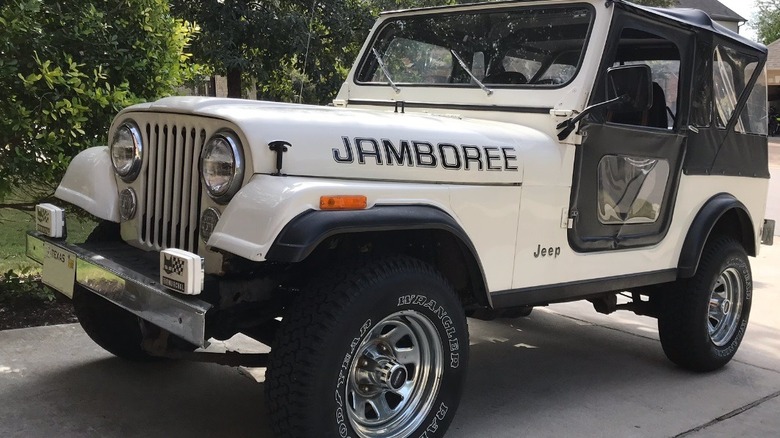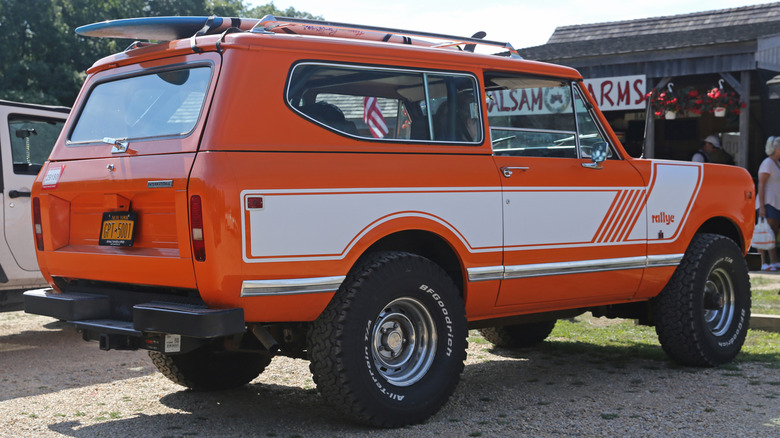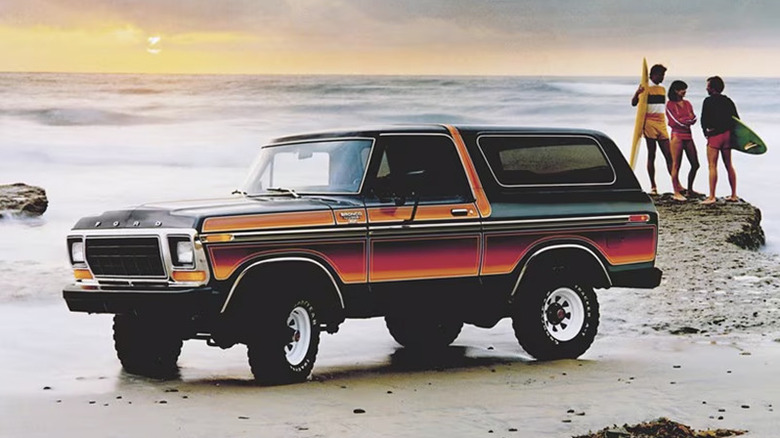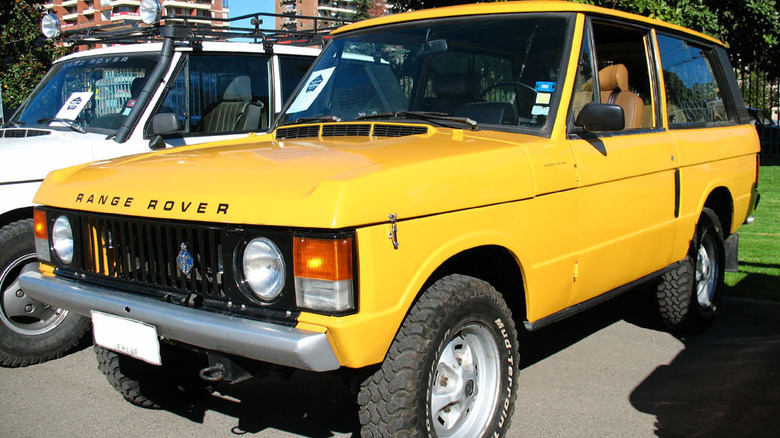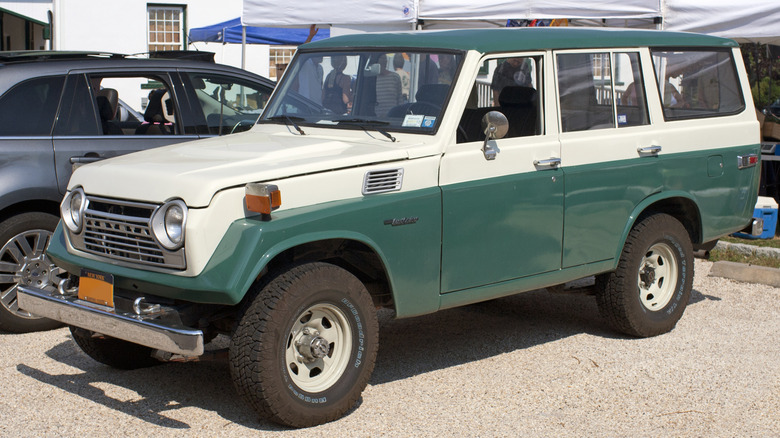6 Of The Coolest SUVs From The 1970s
SUVs have been around longer than you might think, although they didn't become dominant until American buyers began to favor the larger, often four-wheel drive models over station wagons and minivans in the 1990s and early 2000s. The SUV's roots reach back to 1935, when Chevrolet introduced the Carryall Suburban. The Suburban has remained in production through a dozen generations since then, making it the longest continuously produced model in the United States.
The 1973 oil crisis, combined with new federal emissions and fuel economy standards that emerged around the same time, prompted the demise of the American muscle car and kicked off what has become known as the auto industry's malaise era. Despite these speed bumps, the 1970s were a boom time for SUVs. They might not have been as common as station wagons at the time, but automakers cranked out some gorgeous and important SUVs during the decade. Here are a half-dozen of our favorites, chosen for their designs, historical significance, and appreciation in value over time.
[Featured image by Mr.choppers via Wikimedia Commons | Cropped and scaled | Public Domain]
The Jeep CJ series links the brand's past to its present
The Jeep brand was born out of World War II and the light troop and gear carriers built by Willys Overland for the U.S. Army, although custody of the Jeep name has been handed over to a few different corporate overlords since then. Jeep is currently part of Fiat Chrysler, which merged with the Peugeot group to form Stellantis a few years ago. Jeep's most recognizable model is probably the Wrangler, which debuted in 1987, the same year Chrysler acquired the brand. The Wrangler was a replacement for the structurally similar Jeep CJ5 and CJ7, which were both in production during the 1970s.
The CJ5's run from 1954 through 1984 makes it Jeep's longest continuously produced model ever, and the CJ7's lifespan from 1976 through 1986 gives it a '70s presence as well. According to the book "Jeep Off-Road" by Ken Brubaker and Tom Morr, American Motors built close to a million CJ5s, CJ6s, CJ7s, and CJ8s. Many of them are still on the roads and trails today, and there are endless options for upgrading and accessorizing a classic Jeep CJ. If you're lucky, you can find a project CJ from the 1970s for a few thousand dollars and build it into a machine worth many times that. Several fully restored examples have sold for more than $50,000 in the last few years.
The CJ Jeeps are unique among SUVs, which more commonly have a larger, wagon-style body, but the model had a tremendous influence on the segment and even inspired a host of imitators. The line's importance and undeniable cool factor easily earns it a spot on this list.
[Featured image by Ebickel via Wikimedia Commons | Cropped and scaled |CC-BY SA 4.0]
The Blazer Chalet came with a Chinook camper shell
Ford released the Bronco in 1966, and Chevrolet couldn't wait long before responding. For 1969, Chevy introduced the Blazer, which was based on the C and K series Chevy trucks that first appeared in 1960. The Blazer was noticeably larger than its Ford competitor, although it sat on a shorter wheelbase than the C and K trucks with which it shared its front end and engine options. It got its first major update in 1973, including a fully removable roof that remained through 1975. The convertible Blazer was featured in the 1975 blockbuster film "Jaws" as the official department vehicle of Amity Island Police Chief Martin Brody. Starting in 1976, a fixed metal roof covered the front seats and a removable section sat behind.
For 1976 and 1977, Chevy offered the Blazer Chalet, which had a Chinook camper shell that made the SUV more than two feet longer and provided more than six feet of headroom. It lived alongside the GMC Casa Grande for those two years, but only about 1,800 of the twin camper SUV models were produced. One owner, Russell Cook has catalogued more than 150 examples, although he's convinced there are many more to be found. "I'd estimate there are probably another several hundred out there to be found, neglected in storage lots around the country," he said in an interview with Hemmings. "Most owners have no idea how rare these are."
The International Scout II's run spanned nearly the entire decade
The Scout name first appeared on a pickup truck in late 1960, when International Harvester unveiled its new rugged vehicle to the press. The Scout 80 launched in early 1961, with a handful of body configurations and a 152 cubic-inch slant-four engine. International added some refinements over the next few years and introduced the larger and more passenger-friendly Scout 800 in 1966. By the end of the decade, the Blazer and Bronco had joined the SUV fray, and the Scout was updated again for 1971.
The Scout II had power steering, air conditioning, smoother handling, better insulation, and bigger engines. It sold well, and by the middle of the decade, International had introduced power brakes and a few special graphics packages to the Scout II line. The oil crisis and a series of corporate missteps then combined to put International on the verge of bankruptcy, and the company's light truck line was discontinued after 1975.
The Scout II's popularity kept it alive momentarily, but by October of 1980, a dispute with the United Auto Workers and more corporate losses forced International to shut down the Scout division. The badge was recently revived by the Volkswagen Group, which acquired the name along with Navistar in 2021. The new Scout Motors Terra pickup and Traveler SUV came about in a Volkswagen partnership with Rivian.
[Featured image by Mr.choppers via Wikimedia Commons | Cropped and scaled | CC-BY-SA 3.0]
Broncos with the Free Wheeling package had a very '70s paint scheme
Ford introduced the Bronco in 1966, and it immediately became a major player in the emerging SUV sector. It was offered in three body styles with a few different seating configurations, and Ford expanded the Bronco offerings early in the 1970s. The budget-friendly Explorer package debuted in 1972, and the luxurious Ranger version arrived in 1973. In 1977, the last year for the first-generation Bronco, the model was upgraded with Dura-Spark electronic ignition and power brakes.
The Bronco moved to a larger platform for the second generation, sharing some design elements and core components with the F-series pickup. Ford continued to offer a variety of seating options, including captain's chairs for 1979. Custom XLT or Ranger Broncos could be ordered with the Free-Wheeling option package, which included multicolor striping that virtually screamed "1970s," black mirrors and bumpers, and a couple of premium wheel options. The third generation debuted in 1980 and saw the Bronco shrink a bit.
1970s Broncos remain in high demand, with customized first-generation examples routinely fetching six-figure prices. Second-generation Broncos are much more affordable; Classic.com cites an average sale price of a little over $47,000 for the 20 1978 and '79 Broncos that have changed hands over the past five years.
The Range Rover debuted in 1970
There were already a few SUVs on the market when Land Rover introduced the Range Rover in the Summer of 1970, but the British entry immediately upped the segment's standards for luxury and performance. It had a 130-horsepower aluminum V8 engine, full-time four-wheel drive, and disc brakes and coil springs on all four wheels. The Range Rover earned immediate accolades.
In 1971, it became the first vehicle to earn a parking spot in the Louvre, and the next year it established another first by safely traveling from Anchorage, Alaska to the Tierra Del Fuego in Argentina. Part of the journey was across the dangerous and undeveloped Darien Gap, a 250-mile segment that took more than three months to cover. In 1977, a Range Rover won the 4x4 division of the London to Sydney Marathon, a grueling race that covered three continents and more than 18,000 miles, took 30 days, and included two ferry rides.
The first-generation model was produced through the mid-1990s and is now appropriately known as the Range Rover Classic. Many have survived the half-century or so since they were manufactured, although secondhand prices vary widely based on location and condition.
[Featured image by order_242 via Wikimedia Commons | Cropped and scaled | CC-BY-SA 2.0]
Toyota's FJ55 Land Cruiser picked up an unflattering nickname
The Jeep CJ rival J40 Toyota Land Cruiser debuted in 1960, and it was updated to the wagon-style FJ55 in August of 1967. With a folding rear seat that revealed a large cargo area, it was meant to compete with the Suburban and Jeep Wagoneer. The FJ55 became known as the "Iron Pig" for its snout-like front end, but this term was as much of a tribute to the FJ55's sturdiness as it was an insult to its looks. The FJ55 initially used Toyota's 3.9-liter inline-six engine, but it was updated in 1975 to the 4.2-liter six that made 135 horsepower. 4.2-liter FJ55s are easily recognizable by their prominent hood bulge and four-speed manual transmission.
That year also saw the FJ55 get a redesigned front turn signal housing, which had amber and clear lenses stacked vertically. Another change was made to the lights in 1978, when reverse lights and red reflectors were added and the mount point was lowered. The FJ55 yielded to the FJ50 in the Summer of 1980, and Iron Pigs are known to last for decades. Mechanical failures are less common than rust damage, especially along the roof edges, cowl, and rocker panels. Hagerty values an FJ55 in good condition at just under $30,000, but real-world prices can range from below $10,000 to well over $50k.
[Featured image by Mr.choppers via Wikimedia Commons | Cropped and scaled | CC-BY-SA 3.0]

